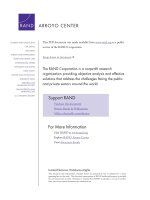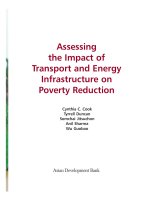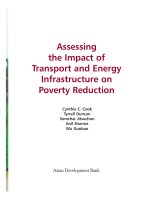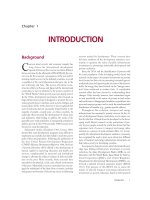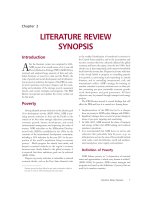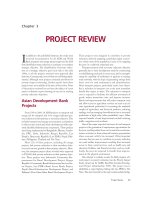Impact of selected yeasts and glycosidase on chemical and volatile composition of mango wine
Bạn đang xem bản rút gọn của tài liệu. Xem và tải ngay bản đầy đủ của tài liệu tại đây (2.06 MB, 167 trang )
IMPACT OF SELECTED YEASTS AND
GLYCOSIDASE ON CHEMICAL COMPOSITION
OF MANGO WINE
LI XIAO
NATIONAL UNIVERSITY OF SINGAPORE
2013
IMPACT OF SELECTED YEASTS AND
GLYCOSIDASE ON CHEMICAL COMPOSITION
OF MANGO WINE
LI XIAO
(B. Sc. (Hons.), NTU)
A THESIS SUBMITTED
FOR THE DEGREE OF DOCTOR OF
PHILOSOPHY
DEPARTMENT OF CHEMISTRY
NATIONAL UNIVERSITY OF SINGAPORE
2013
i
THESIS DECLARATION
I hereby declare that this thesis is my original work and it has been written
by me in its entirety, under the supervision of Dr Liu Shao Quan, (in the Food
Science and Technology research laboratory, S13-05), Chemistry Department,
National University of Singapore, between July 2009 and August 2013.
I have duly acknowledged all the sources of information which have been
used in the thesis.
This thesis has not been submitted for any degree in any university
previously.
The content of the thesis has been partly published in:
1. Li, X., Yu, B., Curran, P., & Liu, S. Q. (2011). Chemical and volatile
composition of mango wines fermented with different Saccharomyces
cerevisiae yeast strains. South African Journal of Enology and
Viticulture, 32, 117-128.
2. Li, X., Yu, B., Curran, P., & Liu, S. Q. (2012). Impact of two Williopsis
yeast strains on the volatile composition of mango wine. International
Journal of Food Science and Technology, 47, 808-815.
3. Li, X., Chan, L. J., Yu, B., Curran, P., & Liu, S. Q. (2012). Fermentation
of three varieties of mango juices with a mixture of Saccharomyces
cerevisiae and Williopsis saturnus var. mrakii. International Journal of
Food Microbiology, 158, 28-35.
4. Lee, P. R., Li, X., Yu, B., Curran, P., & Liu, S. Q. (2012). Non-
Saccharomyces yeasts and wine. In A. S. Peeters (Ed.), Wine: Types,
Production and Health, (pp. 319-333). Hauppauge, New York, USA:
Nova Science Publishers.
5. Chan, L. J., Lee, P. R., Li, X., Chen, D., Liu, S. Q., & Trinh, T. T. T.
(2012). Tropical fruit wine: an untapped opportunity. In D. Cabel (Ed.),
Food and Beverage Asia. Dec/Jan 2011/2012 (pp. 48–51). Singapore:
Pablo Publishing Pte Ltd. ISSN: 2010-2364.
ii
6. Li, X., Chan, L. J., Yu, B., Curran, P., & Liu, S. Q. (2013). Influence of
Saccharomyces cerevisiae and Williopsis saturnus var. mrakii on mango
wine characteristics. Acta Alimentaria, Accepted (in press).
7. Li, X., Lim, S. L., Yu, B., Curran, P., & Liu, S. Q. (2013). Impact of
pulp on the chemical profile of mango wine. South African Journal of
Enology and Viticulture, 34, 119-128.
8. Li, X., Lim, S. L., Yu, B., Curran, P., & Liu, S. Q. (2013). Mango wine
aroma enhancement by pulp contact and β-glucosidase. International
Journal of Food Science and Technology, 48, 2258-2266.
Li Xiao
9 Aug 2013
Name
Signature
Date
iii
ACKNOWLEDGEMENTS
I would like to express the deepest appreciation to my supervisor Dr Liu
Shao Quan for his valuable advice, supervision, guidance and encouragements
throughout the entire project. I feel honored to work with him and I have
learned extensively from his creative ideas, profound knowledge, and in-depth
research experience in the four years. I am also deeply grateful for his
kindness and patience throughout the four years and his countless efforts in
guiding me to complete my research project. Without his guidance and
unwavering help this thesis would not have been possible.
Next, I give my warmest appreciation to Dr Yu Bin who guided me
extensively on techniques of SPME-GC-FID/MS and relative method
development. I also thank the flavorists from Firmenich Asia for their
generous sharing of their knowledge and experience in flavor science and
helpful support on the wine sensory tests.
I would also thank other professors of Food Science and Technology
(FST) program, such as Prof. Zhou Wei Biao, Dr Huang Dejian, Dr Yuk Hyun
Gyun and Dr David Popovich, for their teaching and enlightenment to expand
my knowledge in different aspects of food science through my four-year
study.
In addition, a thank you to my previous honors year students Mr. Lim Sien
Long and Miss Chew Xue Li for their help and commitment in conducting
several experiments. I would also thank my fellow postgraduate students, Dr
Lee Pin Rou, Ms Sun Jing Can, Ms Cheong Mun Wai, Ms Chen Dai and Ms
Chan Li Jie for their suggestions in experiments and moral encouragement. I
am also grateful for all the technical support provided by FST staff Ms Lee
Chooi Lan, Ms Lew Huey Lee, Ms Jiang Xiaohui, Mr. Abdul Rahaman and
Ms Maria Chong.
Last but not least, I would like to thank my parents and my adorable
fiancée Tan Rui for their persistent love, support and encouragement in my
life.
iv
TABLE OF CONTENTS
THESIS DECLARATION i
ACKNOWLEDGEMENTS iii
SUMMARY ix
LIST OF TABLES xi
LIST OF FIGURES xiii
LIST OF ABBREVIATIONS xvii
LIST OF SYMBOLS xix
CHAPTER 1 Introduction and Literature Review 1
1.1 Mango 1
1.2 Mango wine 2
1.3 General comments of wine flavor 5
1.4 Flavor modulation by different techniques 8
1.4.1 Selection of Saccharomyces 9
1.4.2 Selection of non-Saccharomyces 10
1.4.3 Mixed-culture fermentation 11
1.4.4 Yeast interactions in mixed-culture fermentation 13
1.4.5 Enzymes 15
1.5 Objectives of project 16
CHAPTER 2 Materials and Methods 18
2.1 Fruits and yeast strains 18
2.2 Preparation of mango juice and pre-culture 19
2.3 Fermentation 20
2.4 Instrumental and sensory analysis of wine samples 23
CHAPTER 3 Chemical composition of mango wines fermented with different
Saccharomyces cerevisiae yeasts strains 27
v
3.1 Introduction 27
3.2 Result and discussion 27
3.2.1 Brix, pH and yeast growth 27
3.2.2 Changes of sugars and organic acids 28
3.2.3 Volatile compounds in fresh mango juice 29
3.2.4 Volatile composition of mango wines after 14-day fermentation and
kinetic changes of major volatiles 30
3.2.4.1 Alcohols 38
3.2.4.2 Esters 40
3.2.4.3 Volatile fatty acid 42
3.2.4.4 Carbonyl compounds 43
3.3 Conclusion 44
CHAPTER 4 Impact of two Williopsis yeast strains on the volatile
composition of mango wine 45
4.1 Introduction 45
4.2 Results and discussion 45
4.2.1 Yeast growth, sugar consumption, and acidity 46
4.2.2 Volatile compounds and their evolution change 47
4.2.3 Quantification of major volatile compounds 52
4.3 Conclusion 55
CHAPTER 5 Influence of mixed-starter of Saccharomyces cerevisiae and
Williopsis saturnus var. mrakii on mango wine characteristics 56
5.1 Introduction 56
5.2 Results and discussion 56
5.2.1 Yeast ratio screening and population evolution 57
5.2.2 Brix, pH, sugars, ethanol, glycerol and organic acids 58
vi
5.2.3 Evolution of volatiles throughout the fermentation 59
5.2.3.1 Terpenes 59
5.2.3.2 Alcohols 61
5.2.3.3 Fatty acids 64
5.2.3.4 Esters 64
5.2.3.5 Other minor volatiles 66
5.2.4 Sensory test 67
5.3 Conclusion 68
CHAPTER 6 Fermentation of three varieties of mango juices with a mixture
of Saccharomyces cerevisiae and Williopsis saturnus var. mrakii 69
6.1 Introduction 69
6.2 Results and discussion 69
6.2.1 Changes in yeast population, pH,
o
Brix, sugars and organic acids 69
6.2.2 Volatiles composition and their kinetic changes in mango juices and
wines 73
6.2.2.1 Terpenes 73
6.2.2.2 Alcohols 80
6.2.2.3 Esters 81
6.2.2.4 Carbonyls 81
6.2.2.5 Volatile fatty acids 82
6.2.3 Sensory test 82
6.3 Conclusion 83
CHAPTER 7 Antagonistic mechanism between Saccharomyces cerevisiae and
Williopsis mrakii in co- and sequential cultures 85
7.1 Introduction 85
7.2 Results and discussion 85
vii
7.2.1 Early death of W. mrkaii in co-culture with S. cerevisiae 85
7.2.2 Effect of cell density on growth of two yeasts 87
7.2.3 Death of S. cerevisiae in sequential inoculation with W. mrakii 90
7.2.4 Presence of toxic compounds in W. mrakii culture 90
7.3 Conclusion 94
CHAPTER 8 Impact of pulp contact on development of chemical profile of
mango wine 95
8.1 Introduction 95
8.2 Results and discussion 95
8.2.1 Yeast growth,
o
Brix and pH changes 95
8.2.2 Sugar and organic acid contents before and after fermentation 98
8.2.3 Ethanol and glycerol contents of mango wine 98
8.2.4 Volatile profile of mango juice and wine 99
8.2.4.1 Major volatiles in juice 99
8.2.4.2 Evolution of terpenes hydrocarbons 99
8.2.4.3 Evolution of alcohols 105
8.2.4.4 Evolution of fatty acids 106
8.2.4.5 Evolution of esters 107
8.2.4.6 Evolution of sulfur compounds 108
8.3 Conclusion 109
CHAPTER 9 Enhancement of mango wine aroma by β-glucosidase 110
9.1 Introduction 110
9.2 Results and discussion 110
9.2.1 Physicochemical properties of mango wine with maceration and
enzyme treatment 110
9.2.2 Volatiles of mango wine with pulp contact and enzyme treatment 112
viii
9.2.2.1 Terpenols and monoterpene hydrocarbons 112
9.2.2.2 Alcohols 116
9.2.2.3 Esters and fatty acids 117
9.2.2.4 Minor volatile compounds 117
9.2.2.5 Sensory characteristics of mango wine 118
9.2.2.6 Principal component analysis of volatiles in mango wine 120
9.3 Conclusion 121
CHAPTER 10 General conclusions and future work 122
REFERENCES 125
ix
SUMMARY
The project firstly screened the fermentation performance of three strains
of Saccharomyces as well as in two strains of Williopsis saturnus in mango
juice for volatile and non-volatile transformation. S. cerevisiae var. cerevisiae
MERIT.ferm and W. saturnus var. mrakii NCYC500 were selected for
subsequent multi-starter fermentation due to their relatively optimal
production of ethanol and esters.
Generally, S. cerevisiae was the main producer of ethanol, fusel alcohols,
medium to long chain fatty acids and ethyl esters, while W. saturnus was the
main producer of acetate esters and acetic acid but was unable to ferment the
mango wine to dryness. Volatiles that were initially present in mango juice,
such as monoterpene hydrocarbons (C
10
H
16
) rapidly decomposed in the single
culture of S. cerevisiae. Decomposition of the mango varietal aroma was much
slower in the fermentation by W. saturnus. The mixed-culture of the two
yeasts provided the opportunity to not only complete the fermentation but also
improve aroma complexity and balance. But this needs the winemaker to
apply the right ratio of S. cerevisiae and W. mrakii and control the duration of
fermentation.
Three varieties of mango („R2E2‟, „Harum Manis‟ and „Nam Doc Mai‟)
were evaluated for wine-making using mixed-culture fermentation of S.
cerevisiae MERIT.ferm and W. mrakii NCYC500 at a ratio of 1:1000 and the
distinctive characters of each mango variety were analyzed. „R2E2‟ wine had
more fruity, sweet and creamy notes, and retained more of its original
character. „Harum Manis‟ wine had the lowest aroma intensity with more
green and terpenic notes associated with higher levels of residual terpenes.
„Nam Doc Mai‟ wine possessed the highest aroma intensity with winey,
yeasty, fruity and floral notes attributed to higher amounts of alcohols, acetate
esters and ethyl esters.
The antagonistic mechanism of between W. mrakii and S. cerevisiae in
mixed-starter fermentation was also studied. W. mrakii was ethanol sensitive
and was likely inhibited by higher levels of ethanol produced by S. cerevisiae.
S. cerevisiae was sensitive to killer toxin produced by W. mrakii.
x
The project further investigated non-fermentation techniques to improve
mango wine aroma quality such as pulp maceration and exogenous β-
glucosidase addition. Pulp maceration was very efficient in retaining
monoterpene hydrocarbons (e.g. α-terpinolene, δ-3-carene) varietal aroma
compounds of fresh mango. Exogenous β-glucosidase facilitated not only
release of glycosidically bound aroma compounds in mango wine especially
terpenols such as β-citronellol, nerol and geraniol, but also balancing the
relative ratio of acetate/ethyl esters as well as acetic acid/medium-chain fatty
acids.
xi
LIST OF TABLES
Table 3.1 Physicochemical properties, organic acid and sugar concentrations
of mango wines before and after fermentation. 29
Table 3.2 Major volatile compounds (GC-FID peak area ×10
6
) and their
relative peak areas (RPA) in fresh „Chok Anan‟ mango juice. 31
Table 3.3 Major volatile compounds (GC-FID peak area ×10
6
) and their
relative peak areas (RPA) in mango wine (day 14) fermented by
three S. cerevisiae yeasts. 34
Table 3.4 Concentrations of selected volatile compounds (mg/L) and the
corresponding odor activity values (OAVs) in mango wines
fermented with culture of three S. cerevisiae yeasts on Day 14 37
Table 4.1 Physicochemical properties, organic acid and sugar concentrations
of mango wine. 47
Table 4.2 Summary of volatiles in mango juice and wine with 21-day
fermentation 48
Table 4.3 Summary of changes of major terpenoids and their derivatives from
mango juice (day 0) to mango wine after 21-day fermentation 50
Table 4.4 Concentrations of odorants (mg/L) and their corresponding odor
activity values (OAVs) in mango wine fermented with two
Williopsis yeast strains on day 21. 54
Table 5.1 Changes of sugars, organic acids, ethanol and glycerol in mango
wines before and after fermentation 59
Table 5.2 Concentrations, odor thresholds, odor activity values (OAVs) and
odor description of typical odorants in mango wines. 62
Table 6.1 Changes of sugars, organic acids, ethanol and glycerol in mango
wines before and after fermentation of three varieties [„R2E2‟,
„Harum Manis‟ („HM‟), „Nam Doc Mai‟ („NDM‟)] inoculated with
S. cerevisiae and W. mrakii 72
Table 6.2 Categorization of volatiles of fresh mango juices (Day 0) and
mango wine (Day 21) from three varieties. 76
Table 6.3 Concentration, odor thresholds, odor activity values (OAVs) and
odor description of potent odorants in mango wines. 78
Table 8.1 Physicochemical properties, alcohol, organic acid, and sugar
concentrations of mango wines with and without pulp. 97
xii
Table 8.2 Volatiles (mg/L) and their odor activity values (OAVs) of non-
macerated and macerated mango wines. 103
Table 9.1 Physicochemical properties, alcohol, organic acid, and sugar
concentrations of non-macerated and macerated mango wine, with
and without enzyme treatment. 112
Table 9.2 Major volatiles (mg/L) and their odor activity values (OAVs) for
non-macerated and macerated wine, with and without enzyme
treatment 114
xiii
LIST OF FIGURES
Figure 3.1 Changes of alcohols in mango wines during fermentation by S.
cerevisiae MERIT.ferm (), S. chevalieri CICC-1028 (▲) and S.
bayanus EC-1118 (■). 38
Figure 3.2 Changes of acetate esters in mango wines during fermentation by
S. cerevisiae MERIT.ferm (), S. chevalieri CICC-1028 (▲) and S.
bayanus EC-1118 (■). 41
Figure 3.3 Changes of ethyl esters in mango wines during fermentation by S.
cerevisiae MERIT.ferm (), S. chevalieri CICC-1028 (▲) and S.
bayanus EC-1118 (■). 42
Figure 3.4 Changes of fatty acids in mango wines during fermentation by S.
cerevisiae MERIT.ferm (), S. chevalieri CICC-1028 (▲) and S.
bayanus EC-1118 (■). 43
Figure 4.1 Evolution changes of selected terpenoids in mango wine during
fermentation by W. mrakii NCYC500 (▲) and W. suaveolens
NCYC2586 (■). 49
Figure 4.2 Evolution changes of selected alcohols in mango wine during
fermentation by W. mrakii NCYC500 (▲) and W. suaveolens
NCYC2586 (■). 50
Figure 4.3 Evolution changes of selected acetate esters in mango wine during
fermentation by W. mrakii NCYC500 (▲) and W. suaveolens
NCYC2586 (■). 51
Figure 5.1(a) Yeast cell populations during mango wine fermentations
inoculated with different ratios of S. cerevisiae MERIT.ferm (■) to
W. saturnus var. mrakii NCYC500 () = 1:1, 1:10, 1:100, 1:1000.
(b) Yeast cell populations in monoculture (■) or mixed-culture ()
at a ratio of 1:1000 of S. cerevisiae MERIT.ferm to W. saturnus var.
mrakii NCYC500. 58
Figure 5.2 Evolution trend of terpenoids throughout the fermentation of
mango juices: monoculture of S. cerevisiae MERIT.ferm (♦),
monoculture of W. saturnus var. mrakii NCYC500 (▲) and mixed-
culture of S. cerevisiae MERIT.ferm : W. saturnus var. mrakii
NCYC500 = 1:1000 (■). 60
Figure 5.3 Evolution trend of (Z)-3-hexenol and isoamyl alcohol throughout
the fermentation of mango juices: monoculture of S. cerevisiae
MERIT.ferm (♦), monoculture of W. saturnus var. mrakii
xiv
NCYC500 (▲) and mixed-culture of S. cerevisiae MERIT.ferm :
W. saturnus var. mrakii NCYC500 = 1:1000 (■). 61
Figure 5.4 Evolution trend of acetate and ethyl esters throughout the
fermentation of mango juices: monoculture of S. cerevisiae
MERIT.ferm (♦), monoculture of W. saturnus var. mrakii
NCYC500 (▲) and mixed-culture of S. cerevisiae MERIT.ferm :
W. saturnus var. mrakii NCYC500 = 1:1000 (■). 64
Figure 5.5 Sensory profile of mango wines: monoculture of S. cerevisiae
MERIT.ferm (♦), monoculture of W. saturnus var. mrakii
NCYC500 (▲) and mixed-culture of S. cerevisiae MERIT.ferm :
W. saturnus var. mrakii NCYC500 = 1:1000 (■). 68
Figure 6.1 The mean yeast cell population in mango wines (triplicates for
each mango juice) made from varieties „R2E2‟, „Harum Manis‟ and
„Nam Doc Mai‟: S. cerevisiae MERIT.ferm (■) and W. saturnus
var. mrakii NCYC500 (). 70
Figure 6.2 Changes in concentration of fructose, glucose sucrose and ethanol
throughout the fermentation of mango juices of three varieties:
„R2E2‟ (♦), „Harum Manis‟ („HM‟) (▲) and „Nam Doc Mai‟
(„NDM‟) (■) 73
Figure 6.3 (a) Bi-plot of principal component analysis for selected volatiles
of fresh mango juices of three varieties [„R2E2‟, „Harum Manis‟
(„HM‟) and „Nam Doc Mai‟ („NDM‟)]: 1) δ-3-Carene 2)α-
Phellandrene 3)Limonene 4)(Z)-β-Ocimene 5)(E)-β-Ocimene,
6)allo-Ocimene, 7)α-terpinolene 8)β-Caryophyllene 9)β-Selinene
10)Germacrene-D 11)1-Hexanal 12)(E)-2-Hexenal 13)2,6-
Nonadienal 14)Acetaldehyde 15)Acetoin 16)δ-hexanolactone
17)Geranyl acetone 18)γ-octalactone 19)β-Ionone 20)δ-octalactone
21)γ-decalactone 22)δ-nonalactone 23)Ethyl acetate 24)Methyl 2-
butenoate 25)Propyl butyrate 26)Butyl butyrate 27)Ethyl 2-
butenoate 28)3-Hexen-1-ol acetate 29)Ethyl 3-hydroxybutyrate
30)Ethanol 31)1-Penten-3-ol 32)1-Hexanol 33)(Z)-3-Hexenol 34)2-
Hexen-1-ol. (b) Bi-plot of principal component analysis for selected
volatiles in final mango wines of three varieties [„R2E2‟, „Harum
Manis‟ („HM‟) and „Nam Doc Mai‟ („NDM‟)]: 1)ethanol 2)isobutyl
alcohol 3)active amyl alcohol 4)isoamyl alcohol 5)(Z)-3-hexenol
6)2-phenylethyl alcohol 7)ethyl acetate 8)isoamyl acetate 9)(Z)-3-
hexenyl acetate 10)citronellyl acetate 11)2-phenylethyl acetate
12)ethyl hexanoate 13)ethyl octanoate 14)ethyl decanoate 15)ethyl
dodecanoate 16)acetic acid 17)octanoic acid 18)decanoic acid
19)linalool 20)α-terpineol 21)β-citronellol 22)β-damascenone 23) γ-
octalactone 24) β-Ionone 25) δ-octalactone 26) γ-decalactone 27) δ-
nonalacton. 75
xv
Figure 6.4 Evolution trend of terpene hydrocarbons and β-citronellol
throughout the fermentation of mango juices of three varieties:
„R2E2‟ (♦),‟Harum Manis‟ („HM‟) (▲) and „Nam Doc Mai‟
(„NDM‟) (■) 77
Figure 6.5 Evolution trend of (Z)-3-hexenol and isoamyl alcohol, and their
corresponding acetate esters throughout the fermentation of mango
juices of three varieties: „R2E2‟ (♦),‟Harum Manis‟ („HM‟) (▲)
and „Nam Doc Mai‟ („NDM‟) (■) 80
Figure 6.6 Evolution trend of γ-octalactone throughout the fermentation of
mango juices of three varieties: „R2E2‟ (♦),‟Harum Manis‟ („HM‟) (
▲) and „Nam Doc Mai‟ („NDM‟) (■) 82
Figure 6.7 Aroma profile of mango wines from three varieties: „R2E2‟
(♦),‟Harum Manis‟ („HM‟) (▲) and „Nam Doc Mai‟ („NDM‟) (■)
83
Figure 7.1 Cell population dynamics of W. mrakii and S. cerevisiae in co-
culture. Co-inoculation of (a) W. mrakii NCYC500 and (b) S.
cerevisiae MERIT.ferm in nutrient broth with different
concentrations of glucose: 3% (♦), 6% (■), 9% (▲), 12% (×) and
15% (●). 86
Figure 7.2 Cell population dynamics of W. mrakii NCYC500 in nutrient broth
with different concentrations of ethanol: 0% (♦), 2% (■), 4% (▲),
6% (×), 8% (●) and 10% (Ж). 87
Figure 7.3 Cell population dynamics of W. mrakii and S. cerevisiae inoculated
at different ratios. W. mrakii (a) at ~10
5
CFU/mL was co-inoculated
with different concentrations of S. cerevisiae (b) when glucose
concentration was 2% (w/v), S. cerevisiae/W. mrakii=1:1(♦), 1:10(
■), 1:100(▲), 1:1000(●). S. cerevisiae (c) at ~10
5
CFU/mL was
co-inoculated with different concentrations of W. mrakii (d) when
glucose concentration was 2% (w/v), S. cerevisiae/W.
mrakii=1:1(♦), 10:1(■), 100:1(▲), 1000:1(●). 88
Figure 7.4 Cell population dynamics of yeasts in co-cultures inoculated at
different ratios. The growth of W. mrakii (a) in co-culture with S.
cerevisiae (b) at different inoculums when glucose concentration
was 15% (w/v), S. cerevisiae/W. mrakii=1:1(♦), 1:10(■), 1:100(▲
), 1:1000(●). 89
Figure 7.5 Cell population dynamics of yeasts in sequential cultures.
Approximately ~10
4
, ~10
5
, ~10
6
and ~10
7
CFU/mL of S. cerevisiae
(a) was inoculated into the medium seven days after W. mrakii (b)
was inoculated. The starting ratio at day 7 was S. cerevisiae/W.
mrakii=1:1(♦), 1:10(■), 1:100(▲), 1:1000(●). 90
xvi
Figure 7.6 Cell population dynamics of yeasts in supernatants. (a) growth of
S. cerevisiae in cell-free supernatant of W. mrakii on Day 2, and the
inoculums of S. cerevisiae as followed: ~10
1
(♦), ~10
2
(■), ~10
3
(
▲), ~10
4
(×), ~10
5
CFU/mL (●); (b) growth of S. cerevisiae in
cell-free supernatant of W. mrakii on Day 7, and the inoculums of S.
cerevisiae as followed: ~10
1
(♦), ~10
2
(■), ~10
3
(▲), ~10
4
(×),
~10
5
CFU/mL (●); (c) growth of S. cerevisiae in cell-free
supernatant of W. mrakii on Day 14, and the inoculums of S.
cerevisiae as followed: ~10
1
(♦), ~10
2
(■), ~10
3
(▲), ~10
4
(×),
~10
5
CFU/mL (●). 92
Figure 8.1 Yeast growth and changes in
o
Brix for mango wine fermentation
with centrifuged (▲) and uncentrifuged juices (■). 96
Figure 8.2 Evolution trends of terpenes and terpene alcohols during mango
wine fermentation with centrifuged (▲) and uncentrifuged juices (
■). 100
Figure 8.3 Evolution trends of alcohols during mango wine fermentation with
centrifuged (▲) and uncentrifuged juices (■). 106
Figure 8.4 Evolution trends of volatile fatty acids during mango wine
fermentation with centrifuged (▲) and uncentrifuged juices (■).
107
Figure 8.5 Evolution trends of esters during mango wine fermentation with
centrifuged (▲) and uncentrifuged juices (■) 108
Figure 9.1 FID chromatogram of (E)-β-damascenone in non-macerated
control, macerated wine control, non-macerated with enzyme and
macerated wine with enzyme. 118
Figure 9.2 Aroma profile of mango wines: non-macerated control (▲);
macerated wine control (■); non-macerated with enzyme (♦); and
macerated wine with enzyme (×). 119
Figure 9.3 Biplot of principal component analysis of mango wines: non-
macerated control (JCtrl, ▲); macerated wine control (PCtrl, ■);
enzyme-treated non-macerated wine (JEnz, ♦); and enzyme-treated
macerated wine (PEnz, ×): (1) acetic acid; (2) hexanoic acid; (3)
octanoic acid; (4) decanoic acid; (5) dodecanoic acid; (6) ethanol;
(7) isobutyl alcohol; (8) active amyl alcohol; (9) isoamyl alcohol;
(10) (Z)-3-hexenol; (11) linalool; (12) α-terpineol; (13) β-
citronellol; (14) nerol; (15) geraniol; (16) 2-phenylethyl alcohol;
(17) ethyl acetate; (18) isobutyl acetate; (19) isoamyl acetate; (20)
(Z)-3-hexenyl acetate; (21) ethyl hexanoate; (22) ethyl octanoate;
(23) ethyl decanoate; (24) citronellyl acetate; (25) 2-phenylethyl
acetate; (26) ethyl dodecanoate; (27) α-terpinolene. 121
xvii
LIST OF ABBREVIATIONS
ANOVA
Analysis of variance
ABTS
2,2‟-azino-bis(3-ethylbenzothiazoline-6-sulphonic acid
CAS
Chemical Abstracts Service
CFU
Colony forming units
DPPH
2,2-diphenyl-1-picrylhydrazyl
ELSD-LT
Low temperature evaporative light scattering detector
FRAP
Ferric reducing antioxidant power
GC- FID
Gas chromatography-Flame ionization detector
GC-MS
Gas chromatography-Mass spectrometry
HPLC
High performance liquid chromatography
HS-SPME
Head space-solid phase micronextraction
I.D.
Internal diameter
K
2
S
2
O
5
Potassium metabisulfite
LRI
Linear retention index
NCYC
National Collection of Yeast Cultures
N.D.
Not detected
NIST
National Institute of Standards and Technology
OAV
Odor activity values
OD
Optical density
PC 1
First principal component
PC 2
Second principal component
PCA
Principal components analysis
PDA
Potato dextrose agar
xviii
PDMS
Polydimethylsiloxane
PTFE
Polytetrafluoroethylene
R
2
Coefficient of determination
TSS
Total soluble solids
UV
Ultraviolet
YPD
Yeast extract peptone dextrose
xix
LIST OF SYMBOLS
%
Percent
μg
Microgram
μm
Micrometer
μmol
Micromole
o
C
Degree Celsius
eV
Electron volt
G
Gram
H
Hour
kPa
Kilopascal
L
Litre
M
Molar, mol/L
m/z
Mass to charge ratio
m
Meter
mg
Milligram
mm
Millimeter
min
Minute(s)
mL
Millitre
nm
Nanometer
P
Associated significant probability
S
Second
v/v
Volume/volume
w/v
Weight/volume
1
CHAPTER 1 Introduction and Literature Review
1.1 Mango
Mango (Mangifera indica L.) is commercially one of the most abundant
tropical fruits in Southeast and South Asia, accounting for its large market
share of the total mango produced worldwide (Tharanathan, Yashoda, &
Prabha, 2006). Over 30 different varieties of mango are grown and appreciated
for its intense peel coloration, attractive fragrance, delicious taste and high
nutrition value (Spreer, Ongprasert, Hegele, Wünsche, & Müller, 2009).
The chemical composition of mango varies with location of cultivation,
variety, and stage of maturity. The major constituents of the pulp are water,
carbohydrates, organic acids, fats, tannins, vitamins and flavor compounds
(Sagar, Khurdiya, & Balakrishnan, 1999). The rate of starch accumulation is
rapid at the beginning of fruit growth and slows down later, but it continues to
increase up to maturity. Both reducing and non-reducing sugars in mango
were found to be increasing towards the end of maturity (Mann, Singh, &
Pandey, 1974). The main soluble sugars of mango consisted of glucose,
fructose and sucrose. Organic acids include oxalic, citric, malic, succinic,
pyruvic, adipic, galacturonic, glucuronic and mucic acids were identified in
mango, with citric acid being the major one (Tharanathan et al., 2006).
The total sugar content of mangoes varied from 11% to 25% (w/w).
During ripening of mango, both sugar and pH would increase (Tandon &
Kalra, 1984). The increase in sweetness, as a result of glucogenesis, hydrolysis
of polysaccharides (startch), decrease in acidity and accumulation of sugars
and organic acids with an excellent sugar/acid blend are responsible for the
taste development. Twelve amino acids were reported during mango growth
(Tandon & Kalra, 1984). Alanine, arginine, glycine, serine, and leucine,
isoleucine are major amino acids detected in mango. Triglyceride is the major
lipids in mango fruit, but its concentration is generally lower than 1% (w/w)
(Gholap & Bandyopadhyay, 1975). Mango is high in vitamin C, but it reaches
a maximum in the early stage of growth instead of ripening stage (Spencer,
Morris, & Kennard, 1956). However, the change of β-carotene is in a reversed
way. β-Carotene remained low in the beginning and increased as the fruits
2
approached maturity and during ripening (Jungalwala & Cama, 1963; Godoy
& Rodriguez-Amaya, 1987). The increase in β-carotene is accompanied by a
decrease in acids and an increase in sugar content.
The major textural changes resulting in the softening of fruits are due to
enzyme-mediated alterations in the structure and composition of cell wall,
partial or complete solubilization of cell wall polysaccharides (pectins and
celluloses), and hydrolysis of starch and other polysaccharides (Jha, Kingsly,
& Chopra, 2006). The major classes of cell wall polysaccharides that undergo
modifications during ripening are pectins, cellulose and hemicelluloses. The
process is activated by hydrolases and glycosidase (Fuchs, Pesis, &
Zauberman, 1980; Muda, Seymour, Errington, & Tucker, 1995).
The volatile compounds that are involved in mango flavor are produced
through metabolic pathways during ripening, harvesting and post-harvest
storage, and depend on many factors related to the species, variety and type of
technological treatments. More than one hundred volatiles were detected.
Terpene hydrocarbons (monoterpene and sesquiterpene hydrocarbons) are the
major volatiles of almost all varieties. The dominant terpenes are δ-3-carene,
α-pinene, α-phellandrene, α-terpinolene and β-caryophyllene. In addition,
many varieties have considerable amounts of oxygenated volatile compounds,
such as esters (e.g. ethyl 2-methylpropanoate, ethyl butanoate, methyl
benzoate), aldehydes [e.g. (E)-2-nonenal, (E,Z)-2,6-nonadienal, decanal],
furanones (e.g. 2,5-dimethyl-4-methoxy-3(2H)-furanone), lactones (e.g. γ-
hexalactone), C
13
-norisoprenoids [e.g. (E)-β-ionone], etc (Pino, Mesa, Muñoz,
Martí, & Marbot, 2005; Pino & Mesa, 2006). Maturity stage was found to
affect overall flavor of mangoes. Mango harvested at the green stage exhibited
higher amount of monoterpenes, sesquiterpenes, and aromatic compounds, but
fruits harvested at the fully ripe stage had higher concentrations of esters,
alkanes, and norisoprenoids (Lalel, Singh, & Tan, 2003a).
1.2 Mango wine
The shelf-life of mango is short and its availability is mostly restricted to
one season, therefore processed products are likely to have better prospects
3
than fresh fruit in the export market. Various methods of post-harvest handling
have been employed to extend the shelf life of mango fruits and reduce losses,
through inhibition of respiration, refrigeration, dehydration, heat treatment and
ethylene production, which slows deterioration and senescence. Besides,
efforts have been made to use the surplus fruits for various purposes and one
of the alternatives is wine production. Setting-up of fruit wineries could result
in economic growth, generating employment opportunities and providing
better returns of produce to the orchardists (Reddy & Reddy, 2005; Reddy &
Reddy, 2009).
Research on mango wine still lacked intensive drive till recently.
Czyhrinciwk (1966) reported the first study on mango wine production by
testing „Hilacha‟ variety for possibility of converting mango into wine. The
study concluded that mango was an excellent raw material for production of
good-quality fruit wines and was suitable to be fermented into white semi-
sweet table wine (Czyhrinciwk, 1966). In addition, twenty varieties of
mangoes from India were screened for production of dessert and madeira-style
wine and tested for influence of madeirization on organoleptic quality
(Onkarayya & Singh, 1984). Obisanya et al. (1987) studied the fermentation
of mango juice into wine using locally isolated yeasts Saccharomyces
cerevisiae and Schizosaccharomyces species of palm wine and they concluded
that Schizosaccharomyces yeasts were suitable for the production of sweet,
table mango wine and Saccharomyces yeasts were suitable for the production
of dry mango wine with a higher ethanol level (Obisanya, Aina, &
Oguntimein, 1987).
Some recent studies about mango wine started in India in 2005. A method
of mango juice extraction with pectinase was developed. Ethanol as well as
some volatile contents of mango wine was characterized. It was concluded that
the aromatic compounds of mango wine were comparable in concentration to
those of grape wine (Reddy & Reddy, 2005). Further results of characterizing
kinetic changes of higher alcohols in mango wine were reported and it was
concluded that pectinase treatment could enhance the mango juice yield and
increase the synthesis of higher alcohols (within a desirable range) as well as
mango wine quality (Reddy & Reddy, 2009). Response surface methodology
4
(RSM) was used to adjust temperature, pH and inoculum levels of
monocultures of S. bayanus to optimize the production of ethanol, glycerol,
and volatile acidity. They reported that the predicted value for optimisation
process conditions were in good agreement with experimental data (Kumar,
Prakasam, & Reddy, 2009). Furthermore, influence of condition factors
(temperature, pH, SO
2
, and aeration) on mango wine fermentation was further
assessed based on yeast growth, duration, fermentation rate and volatile
composition (Reddy & Reddy, 2011). They concluded that fermentation
temperature and pH had more influence on volatile composition and yeast
biomass. Higher temperature induced a decrease of ethyl acetate and certain
higher alcohols as well as an increase of biomass. SO
2
having a critical value
between 100-300ppm, below which, SO
2
was able to stimulate yeast growth
and fermentation power, but above the critical value SO
2
would inhibit yeast
growth. In addition, initial oxygen in the juice was optimal for yeast growth
and better quality of mango wine.
Various yeast and bacteria strains were used to optimize the flavor of
mango wine. Metschnikowia pulcherrima and Torulaspora delbrueckii were
separately mixed with S. cerevisiae at a ratio of 10:1. The two non-
Saccharomyces yeasts were unable to complete the fermentation, but the
mixed cultures were able to produce similar levels of ethanol to the single
culture of S. cerevisiae, with extra advantages of higher glycerol but lower
volatile and total acidity (Varakumar, Kondapalli, & Obulam, 2012). In
addition, malolactic fermentation was also carried out in mango wine
fermentation. Oenococcus oeni was inoculated simultaneously and
sequentially with S. cerevisiae. The results indicated that wine inoculated with
O. oeni gave higher sensory impact than the control wine (monoculture of S.
cerevisiae), and simultaneous inoculation showed better sensorial attributes in
flavor, fruity aroma, and overall acceptability than sequential inoculation
(Varakumar, Naresh, Variyar, Sharma, & Reddy, 2013).
Furthermore, the complete analysis of volatile compounds of mango wine
was finished by two other groups (Reddy, Kumar, & Reddy, 2010; Pino &
Queris, 2011). Reddy‟s group used liquid-liquid extraction followed by GC-
MS and they reported the concentration of major alcohols, esters, fatty acids




